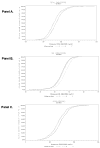Contemporary trends in dyslipidemia in the Framingham Heart Study
- PMID: 19204219
- PMCID: PMC3048065
- DOI: 10.1001/archinternmed.2008.561
Contemporary trends in dyslipidemia in the Framingham Heart Study
Abstract
Background: Recent cross-sectional population studies in the United States have shown an increase in obesity, a decrease in cholesterol values, but no changes in levels of high-density lipoprotein cholesterol (HDL-C) or triglycerides (TG).
Methods: Plasma total cholesterol, HDL-C, and TG levels, measured by the same methods at the 3 most recently completed examinations of Framingham Offspring Study participants (1991-2001), were compared in 1666 participants without prevalent cardiovascular disease, lipid therapy, or hormone replacement therapy (56% were men; mean ages of participants at the first and last examinations, 53 and 60 years, respectively). Changes in age- and multivariate-adjusted mean lipid levels were related to changes in body mass index (BMI).
Results: Over the 3 examinations, comparing the findings of the earliest examination with those of the most recent examination, the mean HDL-C level was significantly increased (multivariate-adjusted means, 44.4 and 46.6 mg/dL in men; 56.9 and 60.1 mg/dL in women; P value for trend, P <.001 in both sexes), whereas levels of TG were decreased (144.5 and 134.1 mg/dL in men; 122.3 and 112.3 mg/dL in women; P value for trend, P = .004 in men and <.001 in women). Over the same time interval, BMI (calculated as weight in kilograms divided by height in meters squared) increased (27.8 and 28.5 in men; 27.0 and 27.6 in women; P value for trend, P < .001 in men and P = .001 in women). There was an inverse relationship between changes in BMI and magnitude of dyslipidemia (ie, individuals with the least increase in BMI had the most favorable changes in levels of HDL-C and TG).
Conclusion: During a 10-year period of recent examinations in the Framingham Heart Study there was a decrease in dyslipidemia with an increase in HDL-C levels and a decrease in levels of TG despite an overall increase in BMI.
Conflict of interest statement
None of the authors have any conflicts of interest to disclose.
Figures


Similar articles
-
Is Isolated Low High-Density Lipoprotein Cholesterol a Cardiovascular Disease Risk Factor? New Insights From the Framingham Offspring Study.Circ Cardiovasc Qual Outcomes. 2016 May;9(3):206-212. doi: 10.1161/CIRCOUTCOMES.115.002436. Epub 2016 May 10. Circ Cardiovasc Qual Outcomes. 2016. PMID: 27166203 Free PMC article.
-
Long-term risk of cardiovascular events across a spectrum of adverse major plasma lipid combinations in the Framingham Heart Study.Am Heart J. 2014 Dec;168(6):878-83.e1. doi: 10.1016/j.ahj.2014.08.007. Epub 2014 Sep 16. Am Heart J. 2014. PMID: 25458651
-
Prevalence of dyslipidemia and associated risk factors in Turkish adults.J Clin Lipidol. 2014 Mar-Apr;8(2):206-16. doi: 10.1016/j.jacl.2013.12.011. Epub 2014 Jan 19. J Clin Lipidol. 2014. PMID: 24636181
-
Triglycerides to high-density lipoprotein cholesterol ratio is superior to triglycerides and other lipid ratios as an indicator of increased urinary albumin-to-creatinine ratio in the general population of China: a cross-sectional study.Lipids Health Dis. 2021 Feb 15;20(1):13. doi: 10.1186/s12944-021-01442-8. Lipids Health Dis. 2021. PMID: 33588849 Free PMC article.
-
Prevalence of lipid abnormalities in the United States: the National Health and Nutrition Examination Survey 2003-2006.J Clin Lipidol. 2012 Jul-Aug;6(4):325-30. doi: 10.1016/j.jacl.2012.05.002. Epub 2012 May 22. J Clin Lipidol. 2012. PMID: 22836069
Cited by
-
Circulating Estrogen Levels and Self-Reported Health and Mobility Limitation in Community-Dwelling Men of the Framingham Heart Study.J Gerontol A Biol Sci Med Sci. 2017 Aug 1;72(8):1137-1142. doi: 10.1093/gerona/glw197. J Gerontol A Biol Sci Med Sci. 2017. PMID: 28329787 Free PMC article.
-
The nine-year changes of the incidence and characteristics of metabolic syndrome in China: longitudinal comparisons of the two cross-sectional surveys in a newly formed urban community.Cardiovasc Diabetol. 2016 Jun 3;15:84. doi: 10.1186/s12933-016-0402-9. Cardiovasc Diabetol. 2016. PMID: 27255215 Free PMC article.
-
Antiobesity and vasoprotective effects of resveratrol in apoE-deficient mice.J Med Food. 2014 Mar;17(3):310-6. doi: 10.1089/jmf.2013.2885. Epub 2014 Jan 16. J Med Food. 2014. PMID: 24433070 Free PMC article.
-
Secular trends in serum lipid levels of a Middle Eastern adult population; 10 years follow up in Tehran lipid and glucose study.Lipids Health Dis. 2014 Jan 23;13:20. doi: 10.1186/1476-511X-13-20. Lipids Health Dis. 2014. PMID: 24456699 Free PMC article.
-
Novel loci for triglyceride/HDL-C ratio longitudinal change among subjects without T2D.J Lipid Res. 2025 Jan;66(1):100702. doi: 10.1016/j.jlr.2024.100702. Epub 2024 Nov 16. J Lipid Res. 2025. PMID: 39557295 Free PMC article.
References
-
- Eckel RH, York DA, Rossner S, et al. Prevention Conference VII: Obesity, a worldwide epidemic related to heart disease and stroke: executive summary. Circulation. 2004;110:2968–2975. - PubMed
-
- Flegal KM, Carroll MD, Ogden CL, Johnson CL. Prevalence and trends in obesity among US adults, 1999–2000. JAMA. 2002;288:1723–1727. - PubMed
-
- Okosun IS, Chandra KM, Boev A, et al. Abdominal adiposity in U.S. adults: prevalence and trends, 1960–2000. Prev Med. 2004;39:197–206. - PubMed
-
- Ford ES, Giles WH, Mokdad AH. Increasing prevalence of the metabolic syndrome among u.s. Adults. Diabetes Care. 2004;27:2444–2449. - PubMed
Publication types
MeSH terms
Substances
Grants and funding
LinkOut - more resources
Full Text Sources
Medical
Miscellaneous

